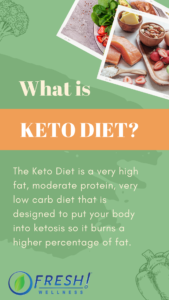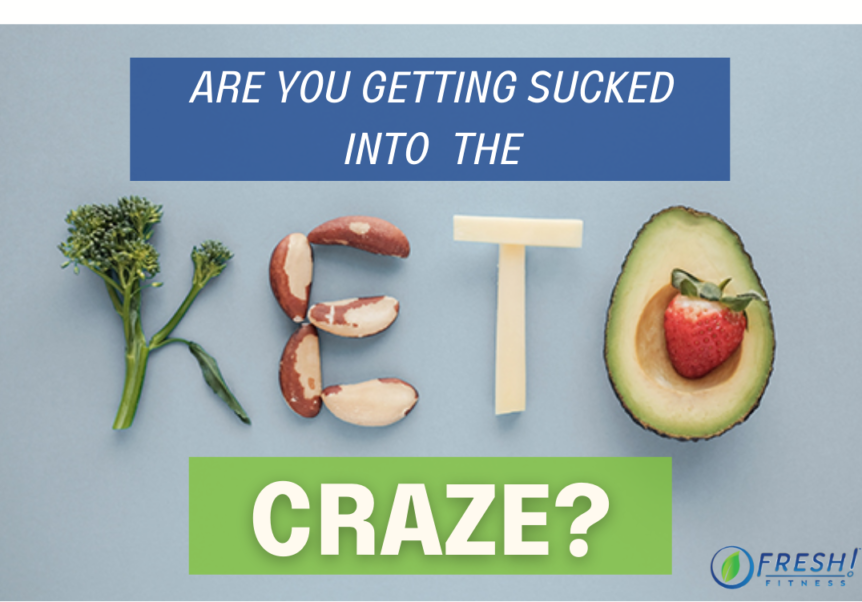I don’t normally “weigh-in” on the fad diet conversation threads. But this time,
I felt compelled to write this post because I’ve been asked a number of times recently about my thoughts on the Keto Diet.
Today I will highlight what the Keto diet is, the issue with dieting in general, and the simple solution that most people overlook.
Without jumping straight onto my soapbox, it’s important to acknowledge why all diets are popular. It’s simple, people aren’t getting the results they want from their normal eating plan.
This lack of results comes back to the day-to-day decisions people make in each of the 4 Pillars (Mindset, Habits, Movement, Fuel). You’ve heard me talk about the 4 Pillars before, but there is a reason they are so important…and interconnected.
I’ve also mentioned before that weight loss and achieving an ideal body composition isn’t about exercise and nutrition. It’s about MINDSET and HABITS.
People know they need to eat well and exercise regularly, they just aren’t doing it consistently!
In fact, the entire concept of a diet is a mindset issue, and at the root of why so many people fail continuously.
Tell me if this makes sense to you:
Someone isn’t happy with the results their current eating habits are producing, so they decide to make a change by going on a diet. However, the nature of a diet means the change is temporary. Once they achieve their results, they stop doing the thing that got them those results in the first place!
Then they get frustrated because they keep gaining back any weight they lost…plus more!
To me, this has always been insanity, and at the root of my issue with dieting!
Outside of this reality, there are a number of other issues with diets.
First, they typically only work for some people, some of the time.
It’s important to note that we are ALL unique and different in our nutritional needs. Our body, activity level, health status, and needs are constantly changing.
Consequently, no single diet or eating plan will be perfect for every person all the time.
Second, diets are often highly restrictive and unsustainable over the long term.
This creates the need to go “on” and “off” a diet, creating additional struggle, frustration, and inconsistency.
So, What is the Keto Diet?
The Keto Diet is a very high fat, moderate protein, very low carb diet that is designed to put your body into ketosis so it burns a higher percentage of fat. Typically the macronutrient ratio is 75% fat, 20% Protein, and 5% Carbohydrates.
The extremely low carbohydrate intake (<50g/day), forces your cells to use fat for fuel and produces ketones as a byproduct. Some of the positive side effects are that it can reduce hunger while also maintaining muscle.
Without going into all the science behind it, the Keto is fairly similar to other low-carb diets such as the Atkins and Zone diet. Though much more extreme on the fat intake (Before the Keto advocates lynch me…YES, there are differences).
The Keto diet has been shown to produce some positive short-term health results in specific populations (i.e. epilepsy, metabolic syndrome, type 2 diabetes, and some neurodegenerative diseases such as ALS).
However, the downside is that ketones can build up causing ketoacidosis. A condition that leads to dehydration and an unhealthy shift in the chemical balance of your blood (a less than ideal situation).
Additionally, as mentioned earlier, the Keto diet is still a diet and has all the failings I mentioned above.
Plus, when you are healthy, exercising regularly, and eating food that is best suited to your needs, your body will naturally use fat for fuel without needing to be in ketosis.
It’s important to remember that virtually any diet will work for some groups of people if it’s followed consistently over time.
There is a reason each type of diet has a hard-core group of advocates. But, remember that any eating plan will only work for a fraction of people and that even if it does, your unique needs may change over time.
It’s important to be able to understand and adapt to these changes.
The great news is that eating well, keeping it consistent, and achieving a healthy body composition is actually very simple.
You can check out the app from FRESH! Wellness Group. It’s available on Apple (iOS) or Android.
Here are the Keys to Nutritional (not Dieting) Success:
Change your Mindset and Perspective on Food
At the base level, food should taste good, be enjoyable to eat, and nourish your body. The way most people view food is at odds with these points.
The diet mentality almost necessitates sacrifice and struggle to be “healthy”. Healthy food is often seen as bland, boring, and devoid of pleasure. This is completely false and extremely harmful to long-term mental and physical health.
Eat REAL Food
This is the most important nutritional factor to practice. Source the best quality, whole, natural, unrefined foods that you can find. It sounds simple, but few people do it.
Many foods you find in the store, or see marketed are actually “fake” foods or “engineered” foods.
When you can get clear about where your food came from, what was done to it, and why you should (or shouldn’t) eat it, you will see a phenomenal change in your health.
Eat at Regular Intervals and Consistent Times
We all have habits and routines in place throughout our day. Some are helpful, others are a hindrance. Setting up a consistent plan for when you eat is extremely important.
Everyone will be different and have an ideal schedule for them. This may also change. However, I typically say that most people will do well with between 3-5 eating sessions each day, spaced at regular intervals.
Easily Manage Portion Sizes
Most portion sizes these days are massive, and people tend to have a skewed perspective of what the ideal portion is.
While it will depend on what you are eating, and your current body size/activity level/metabolism, etc. There is a quick and easy way to dramatically reduce your portions without feeling deprived.
This is to eat your meals out of smaller vessels. An example would be to use side plates and cups instead of dinner plates and bowls.
Scientific studies have shown that we will significantly overeat when eating on larger plates and containers. As a 210 pound active male, I can eat well from side plates. So, unless you are an NFL lineman or professional sumo wrestler, you shouldn’t need more food that can fit comfortably on a small plate.
Forget about counting calories and/or nutrients
Counting calories and nutrients is destructive in many ways. First, not all calories are created equal (i.e. sugar vs. whole, natural foods). Second, not all nutrients are created equal (natural nutrients from real, whole foods vs. lab-produced synthetic vitamins and nutrients added after the fact).
Eat a wide variety of whole, natural, properly grown foods as close to their original state as possible! And you will not have to worry about getting the nutrition you need, and it will be much more challenging to overeat.
Get in touch with your gut and digestive system
Our gut and digestive system is an integral piece of our nutritional communication system. If we train ourselves to listen to it, it will tell us what’s working, what’s not, and what to do to fix any issues. Learning to do this is actually quite simple and easy to do.
This is a big part of what we do with our clients at FRESH! By teaching them to understand their unique metabolic type, listen to their body, and effectively adapt to the ongoing changes in their nutritional needs.
Interested? You can find out more information here
Take time to eat meals and share them with other people
This tip is just to help you remember that food is inherently social and forms part of our community and culture. If you find yourself eating too many meals at your desk, in your car, or while walking between meetings, it’s time to refocus, relax, and enjoy some great food with great people.
It will improve your enjoyment, body composition, and may even boost your career potential…if you are eating with the right people! 🙂
Hopefully, this post has been helpful in navigating the seemingly confusing diet trends and determining what you can do to master the morsels you choose to eat every day.
As always, please reach out with questions, comments, and suggestions. I love connecting with people.
Want to learn the difference between real food and food-type products? Check out our promo 50% off for:



